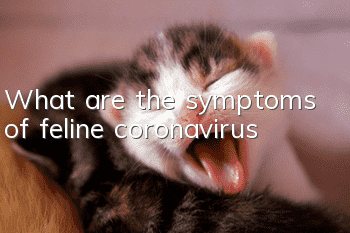What are the symptoms of feline coronavirus?

Symptoms of feline coronavirus:
Feline coronavirus is very common. When checking cat feces, feline coronavirus may often be detected, but most viruses There are no particularly obvious symptoms in animals. Some cats may experience loss of appetite, diarrhea and vomiting, and elevated body temperature, but some cats may not have any symptoms. The virus may undergo genetic mutation. When a special genetic site mutation occurs, it may infect the cat's blood vessels. At this time, symptoms of peritonitis may appear, that is, feline infectious peritonitis. Feline infectious peritonitis is actually a symptom of the coronavirus mutating and eroding blood vessels. The cat may have fever, enlarged abdominal girth, ascites, granulomas, iris discoloration, persistent fever, weight loss and other symptoms. Feline infectious peritonitis is also a disease with a high fatality rate for cats. There are now drugs that can treat it, but the relative mortality rate is still very high.
Common gastroenteritis coronavirus:
Most cats will carry coronavirus. When their immunity is low, cats may be infected by coronavirus. If the virus in the cat’s body does not mutate and is just an ordinary gastrointestinal coronavirus, the cat may be lethargic and unwilling to eat. Then there are some digestive tract reactions, such as vomiting, diarrhea, etc., which in severe cases can cause dehydration. If not treated in time, secondary bacterial infection may occur.
This virus is more harmful to kittens and may lead to death if not treated. However, adult cats have relatively good resistance and immunity. There is usually no great danger after infection, and the cure rate is relatively high.
Virus that mutates into feline infectious peritonitis:
Cats are subject to severe stress response, and the coronavirus in the body mutates, causing the cat to suffer from the disease. Feline infectious peritonitis is commonly known as "cat-borne infection".
Clinically, feline abdominal transmission is divided into dry abdominal transmission and wet abdominal transmission. The mortality rate is as high as 90% or more. Infected cats usually suffer from typical symptoms such as listlessness, loss of appetite, vomiting, and elevated body temperature. symptom. If it is wet cat-abdominal disease, the cat will have an enlarged abdominal circumference and difficulty breathing, while cats infected with dry cat-abdominal disease will have symptoms such as conjunctival luminescence, epilepsy, uncoordinated hind limbs, and visceral enlargement.
- What is the reason why cats don’t get fat after eating?
- How to grow unstuck cat grass
- Cat liver function is not good
- Can cats take hair removal cream if they have cat ringworm?
- What happened if my cat vomited after taking deworming medicine?
- A cat is equivalent to how big a human is in three months
- How many litters does a cat have in a year?
- How many days does a newborn cat open its eyes and defecate?
- How to make a cat more clingy?
- How to trim and bathe Siamese cats’ nails?



